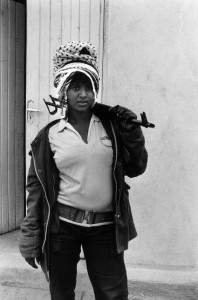

From: Berhane Habtemariam (Berhane.Habtemariam@gmx.de)
Date: Tue Apr 06 2010 - 11:30:25 EDT
Where is Lemlem?
Apr 6, 2010 09:32 EDT
lemlemresizeIt's one of those photos. The type you can't get out of your
head. There's just something about it that draws you in. You keep coming
back to look again.
It could be because she's beautiful. Dark brown eyes, gently rounded cheeks,
bundles of black curls held atop her head by a carefully tied scarf, the
start of a smile she's trying to suppress, a smile you know will charm when
set free.
It could be because she's a soldier. Her AK-47 perched on her shoulder, held
there only by a few fingers, a much-practised position she is comfortable
with.
Most probably it is the combination of both. Beauty and violence. Femininity
and machismo. Supposed contradictions that still fascinate in much of the
world.
But for the Eritrean Peoples' Liberation Front and the Tigrayan Peoples'
Liberation Front - the underdog rebel groups who led the overthrow of
Ethiopia's vicious communist regime in 1991 - such fascination would have
been a luxury. They simply could not have triumphed without their formidable
female fighters.
When American Diallo Hall saw the photo, he was captivated.
Diallo - who is married to an Ethiopian woman - had spent months looking at
the image before he decided he wanted to track the former fighter down.
"It was such a powerful photo that it really struck my curiosity about the
history behind that moment in time," Diallo told me. "I'd like to ask her
about her story, her life since the photo was taken and, perhaps, write her
story for others to hear and learn about. Too often these types of stories
in Africa go untold."
So where do you start when you want to find someone from a photograph taken
in remotest, war-torn Eritrea in 1988? For Diallo the answer was clear:
<http://twitter.com/> Twitter.
"Twitter was just the quickest way to ask people if they knew anything and
to get responses," he said. "Plus, Twitter has been a great way to connect
with a lot of amazing people. Based on their tweets, I knew their areas of
interest."
It wasn't long before Diallo found <http://www.jennymphoto.com/> Jenny
Matthews, the photographer.
Matthews took the photograph in 1988 while on assignment in northern
Ethiopia for British charity War on Want. She had travelled to the frontline
with a group of journalists and had only a few hours to shoot her pictures.
"We arrived a few days after the massive battle at
<http://en.wikipedia.org/wiki/Battle%20of%20Afabet> Afabet. We weren't there
for long, the war was still going on," Matthews told me. "Most of the time
the translator was tied up with television crews so I wasn't able to talk to
people."
The only piece of information Matthews was able to glean from the striking
soldier, quickly scratched down in a notebook, was her name: Lemlem.
Lemlem was an EPLF frontline soldier, Matthews says, and the photo was taken
at Afabet's former Ethiopian army HQ, which had just been taken by the
rebels.
The British photographer chose the image of Lemlem for the cover of her book
<http://www.amazon.com/gp/product/0472089641?tag=apture-20> "Women and War"
and has shown it at several exhibitions over the years.
Now, Diallo's hunt for Lemlem has given Eritrea and Ethiopia their first
ever "trending topic" on Twitter: #whereislemlem? Twitter users start the
topics by putting hash tags before subjects, making them easily searchable
on the site.
Africa still has far less people online than in other parts of the world,
with only 200,000 Eritreans and 360,000 Ethiopians connected to the Internet
in 2008, according to the International Telecommunication Union.
But the Africans who are using the Internet are taking to social networking
sites like Twitter and Facebook in huge numbers, sometimes leapfrogging
straight from inefficient landlines to the latest in communications
technology.
Users from both Eritrea and Ethiopia, their diasporas and beyond have
responded to Diallo's quest and a Facebook group is rapidly gathering
members.
"The reactions have been heartwarming," Diallo says. "You know, even
non-Eritreans are inspired by the experiences of the Eritrean female
soldiers. They weren't just revolutionaries for their country. But they
were really ahead of their time - completely shattering age-old notions of a
woman's role in African society. And the men responded to them as well.
They fought with the women side by side. This type of comradeship between
the sexes should set an example for the continent as to the potential of
empowering both men and women in society."
So where is Lemlem? Did she survive the war? Can you help?
Diallo Hall's Twitter page: http://twitter.com/AddisTunes
"Where is Lemlem?" Facebook group: http://tinyurl.com/yaedabs
PHOTO CREDIT: Jenny Matthews.

----[This List to be used for Eritrea Related News Only]----
